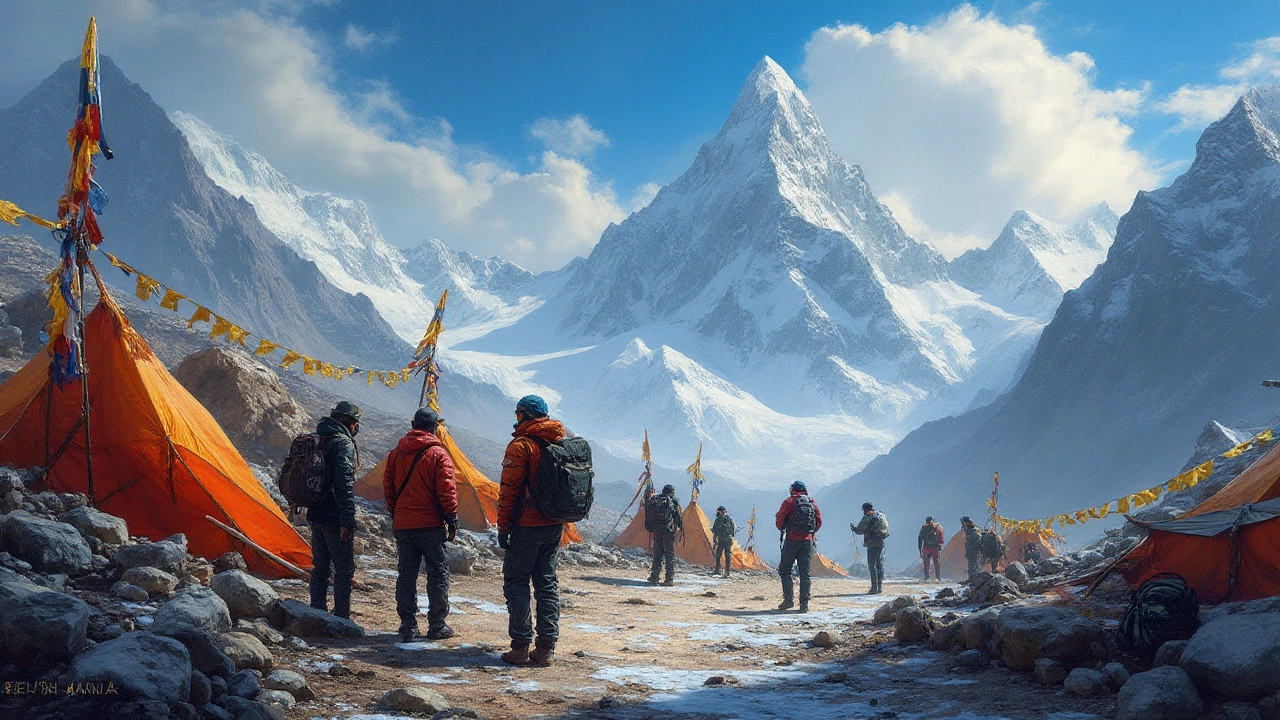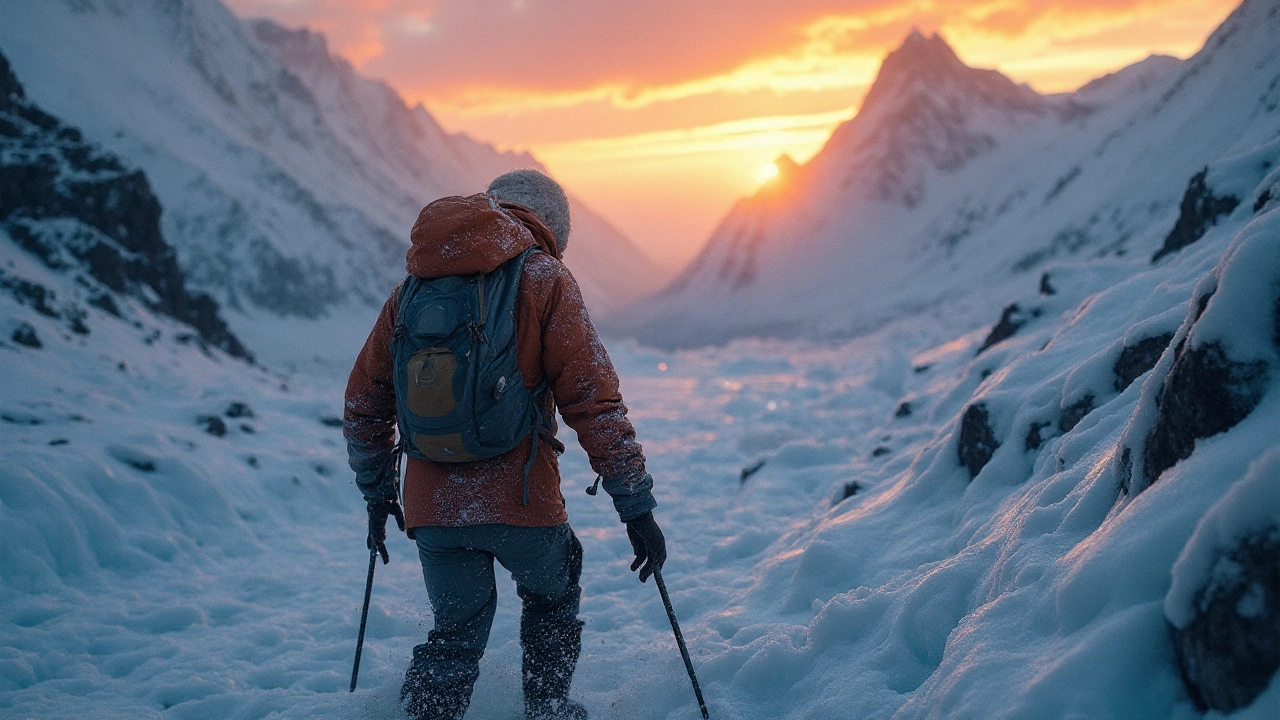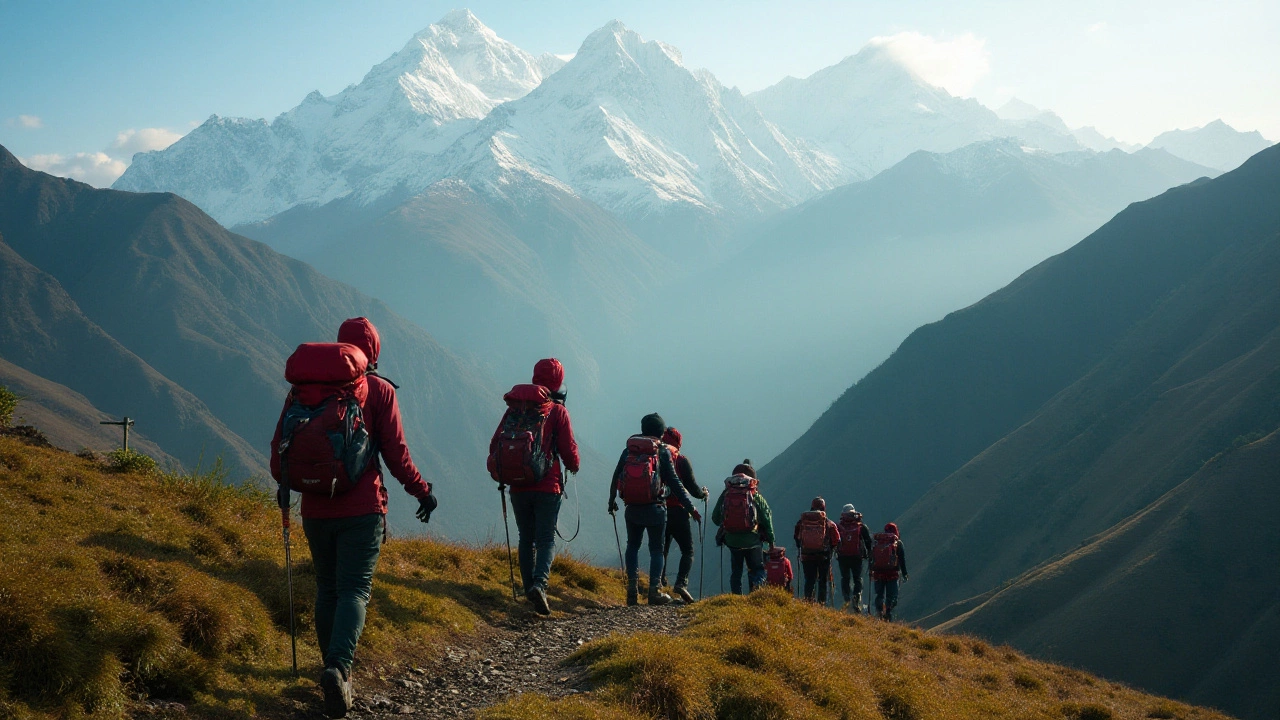The Himalayas, those majestic peaks that scrape the skies, have long been the ultimate destination for trekkers from around the globe. Among these towering giants are Kanchenjunga and Everest, both offering treks that promise breathtaking scenery and profound adventure. Yet, they each challenge adventurers in different ways.
While Everest is often the star of many aspirations, Kanchenjunga remains somewhat a shy enchantress, alluring yet elusive. But what makes one harder than the other? Some might argue it’s a matter of choice—whether you’re seeking the path well-trodden or the road less traveled. Dive into the world of these two colossal peaks and discover which mountain calls to your spirit of adventure.
- Introduction to Kanchenjunga and Everest
- Trekking Routes and Challenges
- Weather and Seasonal Considerations
- Cultural Experiences on the Trails
- Preparation and Safety Measures
- Choosing Your Trekking Adventure
Introduction to Kanchenjunga and Everest
When wandering into the lofty heights of the Himalayas, two of its most captivating summits often capture the dreams of adventurers: Kanchenjunga and Everest. Each stands not only as a testament to nature's grandeur but also as unique challenges that draw trekkers from near and far. At 8,586 meters, Kanchenjunga proudly takes its place as the world's third highest peak, tucked away in the northeastern part of Nepal and parts of Sikkim in India. Its name, translating to 'Five Treasures of the Snow,' pays homage to its five snow-capped peaks, somewhat like a crown jewel basking in nature's isolated realm.
This mighty giant's calling card is its relative remoteness, offering an earnest trekking experience less populated by the bustling crowds found on Everest. It carries aura, a pure, unhindered connection with the untamed wilderness. Everest, or Sagarmatha as the locals call it, towers over all at 8,848 meters. It's a global icon, a celebrity if you will, drawing those with dreams of conquering the impossible. Known as Chomolungma to the Tibetan folk, meaning 'Goddess Mother of the World', it's etched in hearts as the quintessential symbol of human daring and perseverance. A tapestry of routes unfolds each with its tale, whether it’s the classic South Col through Nepal or the ancient North Col treks via Tibet.
In comparing these monumental paths, one doesn't merely weigh heights or distances but rather the very spirit of the journey.
"Kanchenjunga is about embracing solitude in the quiet hush of pristine landscapes," remarked celebrated mountaineer Phil Britton, "while Everest challenges you with the sheer force of its fame and the shared energy of those who walked before."Though shorter, Kanchenjunga's trails ask much with their demanding paths and an allegiance to preserving the environment that keeps modernization at bay. In contrast, the Everest region, with its thrumming Sherpa culture and diverse ecosystems, melds high-altitude trekking with vibrant communal encounters, creating a dynamic trek influenced by decades of climbing history.
For both mountains, the weather and season play pivotal roles in setting the tone of the trek. Each offers its dance with the elements, where the monsoons wash over trails and winter's grip decorates vistas with icy brilliance. Navigating these paths requires more than just physical stamina; it demands preparation, respect for the terrain, and an understanding of the spiritual undertones deeply woven into the local cultures. Everest might loom as the more daunting name worldwide, however, Kanchenjunga beckons those who seek something deeper, resonating with an explorer's heart longing for solitude in a world swiftly modernizing.
Whether drawn by the lure of Kanchenjunga's quiet mystery or the relentless pull of Everest's legendary slopes, each mountain promises an unforgettable story. A rich tapestry awaits, woven with experience and challenge, for those daring enough to lace up their boots and embark on these storied trails.
Trekking Routes and Challenges
When it comes to trekking in the Himalayas, each route tells a different story of nature's staggering beauty and the humbling scale of the environment. The Kanchenjunga trek isn't just a walk in the wilderness; it's a journey into some of the most secluded parts of the Nepal-India border area. Known for its raw, untamed wilderness, the trek takes you through deep valleys and steep ridges. The trail is less commercialized and sees fewer trekkers, enhancing the feeling of solitude amidst nature’s grandeur. Trekkers often start from Taplejung in Nepal, moving through quaint villages, where time seems to have stood still, before reaching the base camp.
On your way to Kanchenjunga, the challenges are as much mental as they are physical. The paths are rugged, and the altitudes can be breathtakingly high. This trek is demanding, often requiring more than three weeks to complete. The longer duration necessitates meticulous planning regarding supplies and acclimatization strategies. Many trekkers share that the journey is not just about the destination, but about immersing oneself in the local culture and the mesmerizing scenery along the path.
Everest, on the other hand, is renowned for its established routes that come alive with trekkers from every corner of the globe. The Everest Base Camp trek is perhaps the most famous, starting from Lukla, accessible by a thrilling flight. From here, the trail winds through beautiful Sherpa villages like Namche Bazaar and gently ascends through the Sagarmatha National Park. As you walk, you are treated to incredible views of the towering peaks, including the mighty Nuptse, Lhotse, and, of course, Everest itself.
"The best journeys in life are those that answer questions you never thought to ask," shares Sir Edmund Hillary, a testament to the introspective nature of mountain treks.
This trek offers a mix of cultural and natural exposure, with challenges posed by high altitudes and unpredictable mountain weather. Typically completed in 12 to 14 days, it requires solid physical fitness and a good acclimatization plan. As both treks present their unique trials, it's crucial to prepare adequately, taking into account the weather and terrain peculiarities. The Everest trek benefits from more accessible amenities and infrastructure due to its popularity, such as lodges and dining options along the way, reducing some logistical challenges faced by those trekking Kanchenjunga.

Weather and Seasonal Considerations
Weather plays an incredibly significant role in determining the feasibility and safety of any trekking expedition in the Himalayas. When it comes to both Kanchenjunga and Everest, understanding the seasons and what they bring is key to planning a successful trek. The Himalayas have two primary trekking seasons: pre-monsoon or spring, and post-monsoon or autumn. Each season offers its own set of challenges and beauty.
Kanchenjunga lies in a region that's still largely unexplored, which means weather reports may not always be as timely or accurate compared to Everest. The spring months from March to May are generally suitable for trekking, with relatively moderate temperatures and clear skies. However, trekkers should be prepared for unpredictable changes. The autumn, from late September to November, is also favorable, offering clear weather and stunning views. Yet, due to its high latitude and altitude, sudden snowstorms or temperature drops can occur, altering the landscape drastically within hours.
In contrast, Everest, with its plethora of well-documented routes and infrastructure, offers more predictable trekking conditions. The established routes have consistent weather updates which trekkers can rely on. Spring on Everest is bustling with activity as climbers prepare for summit attempts, and the trails are alive with diverse wildlife emerging from their winter slumber. Autumn presents another beautiful window with stable weather patterns and clearer skies, perfect for viewing the towering peaks unmarred by the haze of summer.
Both peaks experience the ferocity of the monsoon from June to September, where heavy rains on the lower elevations and snow at higher altitudes can make trekking both difficult and dangerous. During this period, trails become slippery, and the risk of landslides in the lower reaches increases, making Kanchenjunga particularly challenging due to its remoteness. Winter, from December to February, blankets both mountains in heavy snow, cutting off paths and making most trekking routes impassable. Yet, the solitude and stark beauty during these months attract seasoned winter trekkers.
"Understanding the seasonal shifts is critical for a safe trek. Each mountain demands respect, and knowing when to bow to nature’s whims is part of the adventure," said renowned mountaineer Reinhold Messner.
In conclusion, whether choosing Kanchenjunga with its raw, untouched splendor or Everest with its structured convenience, a successful trek largely depends on timing your journey with nature’s rhythms. Always stay updated on the weather reports and prepare to adjust plans as needed – the mountains, after all, have their own temperamental schedules.
Cultural Experiences on the Trails
Trekking through the Himalayas, particularly on the trails of Kanchenjunga and Everest, offers more than just an encounter with raw nature. These trails are alive with the pulse of the people who call these remote regions home, offering a tapestry of cultural experiences that can profoundly impact any traveler. As you venture through the dense forests, rocky paths, and serene villages, magic unfolds in the form of local encounters and traditions.
On the Kanchenjunga trek, the remoteness of the journey means each village feels like a hidden gem. These areas are predominantly inhabited by the Limbu and Rai communities, known for their vibrant customs and hospitable nature. Visitors often find themselves welcomed into homes for a cup of tongba—a local millet brew that warms even the coldest nights. You might witness traditional dances performed in colorful attire, each step narrating stories of bravery and folklore passed down through generations. Trekkers often carry these stories as precious souvenirs, linking them to a part of the world few have truly seen.
The Everest trail, on the other hand, immerses you in Sherpa culture with its bustling teahouses and timeless monasteries. The region is a melting pot of traditions, but it's the deep-rooted Buddhist faith that leaves an indelible mark. As trekkers pass through Namche Bazaar, the gateway to Everest, they often find themselves pausing at Tengboche Monastery, a spiritual haven set against the backdrop of the towering peaks. Here, the sound of monks chanting and the scent of burning incense evoke a sense of peace and introspection. It is a tradition for climbers to receive a blessing from the monks for a safe passage, a practice as enriching for the soul as the trek is for the body.
Both mountains offer endless opportunities to learn and reflect through the diverse cultures found along their paths. As one local Sherpa guide famously said,
"The mountain stops you, teaches you to breathe with the earth, and in its silence, you learn to listen."Such profound teachings are often accompanied by the heartfelt warmth of the local people, whose resilience and kindness are as towering as the mountains themselves.
Travelers are encouraged to engage with these communities respectfully and thoughtfully. Participation in local activities, understanding regional histories, and even learning a few phrases in the local dialect can greatly enhance the experience. A trekker's journey through these cultural experiences often leads to a deeper connection with the very essence of the human spirit, making the arduous trek not just a physical accomplishment but a journey into the heart of another world.

Preparation and Safety Measures
Preparing for a trek to either Kanchenjunga or Everest is not just about stuffing gear into a pack and setting off. It's an expedition that demands careful planning and a genuine respect for the natural elements you'll face. Both mountains reside in the Himalayas, where the weather can be as unpredictable as it is brutal. A comprehensive physical fitness routine is vital. Training should involve cardio exercises, strength building, and endurance workouts since these treks often push participants to their physical limits over many days at very high altitudes. Consistent training routines several months in advance can significantly increase your chances of a successful and enjoyable journey.
Acquiring suitable gear is essential, as the equipment serves as your lifeline against the harsh conditions. Layers are your friend—moisture-wicking base layers, insulating mid-layers, and waterproof outer shells will help combat the varying temperatures. Don't overlook quality shoes; investing in a pair specifically designed for trekking can prevent the misery of blisters and ensure support over rough terrains. Essential accessories like trekking poles, headlamps, and GPS devices can be invaluable in low visibility conditions.
Part of the preparation is gaining an understanding of the route's difficulties and acclimatization processes. High altitudes on both Kanchenjunga and Everest pose the risk of altitude sickness. Ascending slowly and allowing your body to adjust is crucial. Consider hiring a guide who can offer reassurance and local insight. They can help with navigation, which is especially beneficial on the complex and less frequented trails of Kanchenjunga. It's said, "Mountains have a way of dealing with overconfidence," and this could not be truer when tackling these majestic giants.
"There is no such thing as bad weather, only inappropriate clothing." – Alfred Wainwright
Safety is paramount, and having a robust travel insurance policy tailored for high-altitude trekking is non-negotiable. This should cover potential accidents, emergency evacuations, and medical assistance. Communicate your itinerary with someone you trust before embarking. Reliable communication devices are vital; check if satellite phones are feasible, as cell signals may be sparse. In tight spots, the ability to contact assistance could be lifesaving.
Kanchenjunga offers a more remote experience with less infrastructure, which presents an additional layer of complexity. Unlike the famed routes to Everest's base camp, where lodges and teahouses line the path, Kanchenjunga's trails are raw and rugged, meaning provisions for a self-sustained trekking expedition are necessary. Stock up on non-perishable, high-energy food, as well as water purification systems, since you will encounter fewer vendors along the way. Both mountains demand respect, planning, and humility. Trekking them is not merely about reaching a goal, but about the journey—a journey where preparation could very well be the linchpin that turns a trek into a triumphant adventure.
Choosing Your Trekking Adventure
Embarking on a trek in the Himalayas is a decision that can transform your outlook on life. Yet, choosing between the formidable Kanchenjunga and the renowned Everest treks requires thoughtful consideration. These two giants offer vastly different experiences, urging you to weigh what kind of adventure your heart truly seeks. Kanchenjunga, though lesser-known in the mainstream trekking community, beckons with serene paths that snake through remote lush greenery and tranquil villages. This trek is the epitome of solitude, a soulful journey where you can truly disconnect from the chaos of modern life. One must be well-prepared for the physical exertion it demands, as the trails are less frequented and facilities sparse.
In contrast, Everest offers a myriad of routes, catering to various levels of trekking enthusiasts. The most popular, the Everest Base Camp trek, is bustling with a camaraderie of adventurers from around the globe. Known for its hospitable tea houses and well-trodden paths, it presents a more social experience where every turn is a shared story, every climb a shared triumph. The decision ultimately rests upon whether you crave the isolation and pure connection with nature that Kanchenjunga provides or the exhilarating community experience found on Everest.
A vital part of the decision-making process is understanding the trekking season and weather patterns. The best time to undertake these treks is typically in the pre-monsoon (March to May) and post-monsoon (late September to November) periods. Kanchenjunga sees fewer trekkers, allowing for a genuine wilderness experience even in peak trekking seasons. The ability to adapt to unpredictable weather is crucial for both treks, but particularly for Kanchenjunga where infrastructure support is minimal.
To equip yourself for these challenges, there’s a unanimous agreement across experienced trekkers on the importance of prior conditioning and preparation. Establishing a robust fitness regime months before the trek can significantly enhance your experience. Opt for strength training, cardio, and hiking practice with a loaded backpack. The rigorous nature of both treks should not be underestimated. Packing smartly—with essential gear for cold weather, rain protection, and emergency medical supplies—is non-negotiable. Trekking with a reliable guide or joining an authorized trekking group helps vastly in navigating the intricacies of the trail.
It’s also worthwhile to educate yourself about the cultural tapestry you’ll encounter on these treks. Kanchenjunga offers intimate interaction with local cultures like the Limbu and Rai, who inhabit its serene valleys. Engaging with them provides rare insights into traditions untouched by time. On the Everest trail, the warm Sherpa culture welcomes you with open arms, offering tales of mountain lore and adventure from generations past. Acknowledging and respecting cultural sensitivities forms an integral part of the trekking experience.
Finally, as you stand at the crossroads of choice, let your instincts guide you. As mountaineer Sir Edmund Hillary once remarked, "It is not the mountain we conquer, but ourselves." Each trek offers a chance for self-discovery, testing your courage and resilience while rewarding you with vistas that are simply out of this world. Whether it’s the mystical call of Kanchenjunga or the legendary pull of Everest, the Himalayas await to etch their breathtaking impressions upon your spirit.
